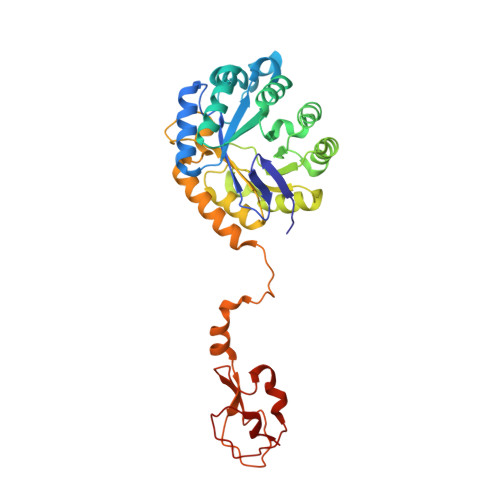NeuNAc Oxime: A Slow-Binding and Effectively Irreversible Inhibitor of the Sialic Acid Synthase NeuB.
Popovic, V., Morrison, E., Rosanally, A.Z., Balachandran, N., Senson, A.W., Szabla, R., Junop, M.S., Berti, P.J.(2019) Biochemistry 58: 4236-4245
- PubMed: 31549502
- DOI: https://doi.org/10.1021/acs.biochem.9b00654
- Primary Citation of Related Structures:
6PPW, 6PPX, 6PPY, 6PPZ - PubMed Abstract:
NeuB is a bacterial sialic acid synthase used by neuroinvasive bacteria to synthesize N -acetylneuraminate (NeuNAc), helping them to evade the host immune system. NeuNAc oxime is a potent slow-binding NeuB inhibitor. It dissociated too slowly to be detected experimentally, with initial estimates of its residence time in the active site being >47 days. This is longer than the lifetime of a typical bacterial cell, meaning that inhibition is effectively irreversible. Inhibition data fitted well to a model that included a pre-equilibration step with a K i of 36 ¦ÌM, followed by effectively irreversible conversion to an E*¡¤I complex, with a k 2 of 5.6 ¡Á 10 -5 s -1 . Thus, the inhibitor can subvert ligand release and achieve extraordinary residence times in spite of a relatively modest initial dissociation constant. The crystal structure showed the oxime functional group occupying the phosphate-binding site normally occupied by the substrate PEP and the tetrahedral intermediate. There was an ¡Ö10% residual rate at high inhibitor concentrations regardless of how long NeuB and NeuNAc oxime were preincubated together. However, complete inhibition was achieved by incubating NeuNAc oxime with the actively catalyzing enzyme. This requirement for the enzyme to be actively turning over for the inhibitor to bind to the second subunit demonstrated an important role for intersubunit communication in the inhibitory mechanism.
Organizational Affiliation:
Department of Biochemistry, Molecular Biology Lab , Western University , London , ON N6A 5C1 , Canada.

















